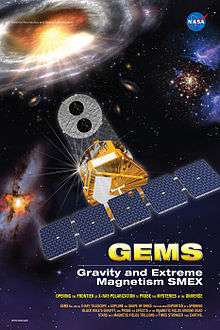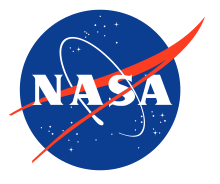Gravity and Extreme Magnetism
The Gravity and Extreme Magnetism SMEX (GEMS) mission was a cancelled space observatory mission. The main scientific goal of GEMS was to be the first mission to systematically measure the polarization of cosmic X-Ray sources. GEMS would have provided data to help scientists study the shape of spacetime that has been distorted by a spinning black hole's gravity and the structure and effects of the magnetic fields around neutron stars. It was cancelled by NASA in June 2012 for potential cost overruns due to delays in developing the technology.
 Artist's impression of GEMS | |
| Names | SM X-13 |
|---|---|
| Mission type | X-ray astronomy |
| Operator | NASA |
| Website | gems.gsfc.nasa.gov |
| Mission duration | 9 months (primary) [1] 15 months (extended) |
| Spacecraft properties | |
| Bus | LEOStar-2/750 |
| Manufacturer | Orbital Sciences Alliant Techsystems |
| Launch mass | 288.7 kg (636 lb) [1] |
| Dimensions | 7.12 m × 2.73 m (23.4 ft × 9.0 ft) |
| Start of mission | |
| Launch date | Cancelled |
| Rocket | Pegasus XL [1] |
| Launch site | Stargazer Cape Canaveral AFS |
| Contractor | Orbital Sciences |
| Orbital parameters | |
| Reference system | Geocentric |
| Regime | Low Earth |
| Eccentricity | 0° |
| Perigee altitude | 575 km (357 mi) |
| Apogee altitude | 575 km (357 mi) |
| Inclination | 28.5° |
| Epoch | planned [1] |
| Instruments | |
| X-ray Polarimeter Instrument | |
Small Explorer program | |
GEMS was managed by the National Aeronautics and Space Administration NASA, the United States space agency, at the Goddard Space Flight Center. The project was an astrophysics program reporting to NASA's Science Mission Directorate (SMD) in Washington, D.C..[2]
The spacecraft would have been launched on in July 2014 on a nine-month mission with a possible 15-month extension for a guest observer phase;[3] but the mission was terminated at the Confirmation Review stage on May 10, 2012 due to expected cost overruns.
Cancelled missions can be reinstated—for example, NuSTAR was cancelled in 2006, but reinstated a year later and launched in June 2012.[4] However, NuSTAR was not cancelled due to project overruns, but rather due to changes in the overall NASA budget, so the circumstances for cancellation were very different. Small missions of the Explorer program offer much flexibility and launch opportunities, and the lessons learned can be applied to the same missions goals, but on a different mission (compare, for instance, Vanguard 1 to Explorer 1). Several years later two new X-ray polarimetry missions won a NASA award to develop X-ray polarimetry missions.[5]
Mission

The GEMS X-ray telescope was designed to indirectly measure the regions of distorted space around spinning black holes through a measurement of the polarization of X-rays emitted. It would have also probed the structure and effects of the magnetic fields around magnetars and other star remnants with magnetic fields trillions of times stronger than Earth's.
GEMS could reveal:
- How spinning black holes affect space-time and matter as it is drawn in and compressed by strong gravitational fields.
- What happens in the very strong magnetic fields near pulsars and magnetars.
- How cosmic rays are accelerated by shocks in supernova remnants.[6]
Current missions cannot do this because the required angular resolution is limited and magnetic fields are invisible.
The detector in GEMS would have been a small chamber filled with gas. When an X-ray is absorbed in the gas, an electron carries off most of the energy, and starts out in a direction related to the polarization direction of the X-ray. This electron loses energy by ionizing the gas; the instrument measures the direction of the ionization track, and thereby the polarization of the X-ray. The GEMS detector readout will employ a time projection chamber to image the track. The GEMS instrument is about 100 times more sensitive than previous X-ray polarization experiments.
Mission costs were capped at US$105 million (in Fiscal Year 2008 dollars), excluding the launch vehicle,[7] but an independent confirmation review board at NASA claimed it would grow to an estimated $150 million, leading to cancellation of the mission.
The cancellation of GEMS marks the end of a multi-year-long binge of cancellations and attempted cancellations of current and future missions: it was at the time the last funded future U.S. space telescope besides JWST. The cancellation of GEMS may have jeopardized the Pegasus XL launcher.[8] (The Pegasus XL has successfully launched other small explorer missions)
Project Status
GEMS was one of six Small Explorer missions selected in May 2008 for the NASA Small Explorer (SMEX) Program Phase A study.[9] In June 2009, GEMS was chosen to be the second of these missions to go forward into Phase B, starting in October 2010 for a launch in April 2014.[7]
The project completed and successfully passed the Systems Requirements Review (SRR) Design review (US Government) in December 2010.[10]
GEMS did not pass a confirmation review conducted on May 10, 2012, which effectively cancelled the project. The project team intended to appeal the cancellation.[11]
On June 7, 2012, NASA officially announced the cancellation of the GEMS project. The mission was supposed to launch in 2014 to study black holes and neutron stars, but external reviews found the project would likely exceed its budget. GEMS was supposed to hold at $119 million, not counting the rocket. NASA's astrophysics director, Paul Hertz, says the technology needed for the instrument took longer to develop than expected, and that drove up the price.[12]
NASA continued studying X-ray polarimetry missions in 2015 for future Explorer program observatories.[5]
Project and Science Team
The GEMS Principal Investigator is Dr Jean H. Swank, of NASA's Goddard Space Flight Center, Greenbelt, Maryland.
Project Team
- GSFC will be responsible for the GEMS instrument, system engineering, spacecraft contract, and the overall program management.
- Ames Research Center will provide Co-Investigators and perform the Education and Public Outreach(EPO)support.
- The satellite will be built by Orbital Sciences using its LEOStar-2 TM spacecraft bus design, and will also conduct mission operations, under a US$40 million contract.[13]
- Alliant Techsystems (ATK) will build a deployable boom to place the X-ray mirrors at the proper distance from the detectors or polarimeters.
- The University of Iowa will provide instrument calibration assistance and will have students prepare a small instrument that could be part of the mission.
Science Team
Co-Investigators
Science Collaborators
Other GEMS collaborators are from universities include:[1][14]
- Johns Hopkins University
- Cornell University
- Rice University
- University of Oulu (Finland)
- North Carolina State University
- Washington University
References
- "GEMS Project Website". NASA. Retrieved May 22, 2011.
- "NASA Science Mission Directorate GEMS Site". NASA. Retrieved May 22, 2011.
- GEMS, Smithsonian Astrophysical Observatory, accessed 2011-05-23
- W. Graham - Orbital’s Pegasus successfully launches NASA’s NuSTAR spacecraft (June 13th, 2012)
- NASA Selects Proposals to Study Neutron Stars, Black Holes and More
- "Proposed NASA Mission Could Explore Twisted Space Around Black Holes". NASA. 2008-06-30. Retrieved 2009-08-14.
- "NASA Awards Two Small Explorer Development Contracts". NASA. 2009-06-19.
- D. Leone - Demise of GEMS May Cost Orbital 150 Jobs, Doom Pegasus (2012) - Space News
- NASA Selects Small Explorer Investigations for Concept Studies, NASA media release C08-029, 2008-05-29, accessed 2009-08-14
- NASA SMD Astrophysics Program Letter, NASA, 2011-04-28, accessed 2010-05-23
- "NASA To Cancel GEMS X-Ray Telescope". Space News. 4 June 2012. Archived from the original on 3 February 2013.
- NASA kills GEMS X-ray telescope, blames project's cost
- "Orbital To Build New Space Science Satellite To Study X-Ray Polarization". SpaceMart. 2009-07-09. Retrieved 2009-08-14.
- GEMS home page, accessed 2009-08-14
External links
| Wikimedia Commons has media related to GEMS (space telescope). |

.png)